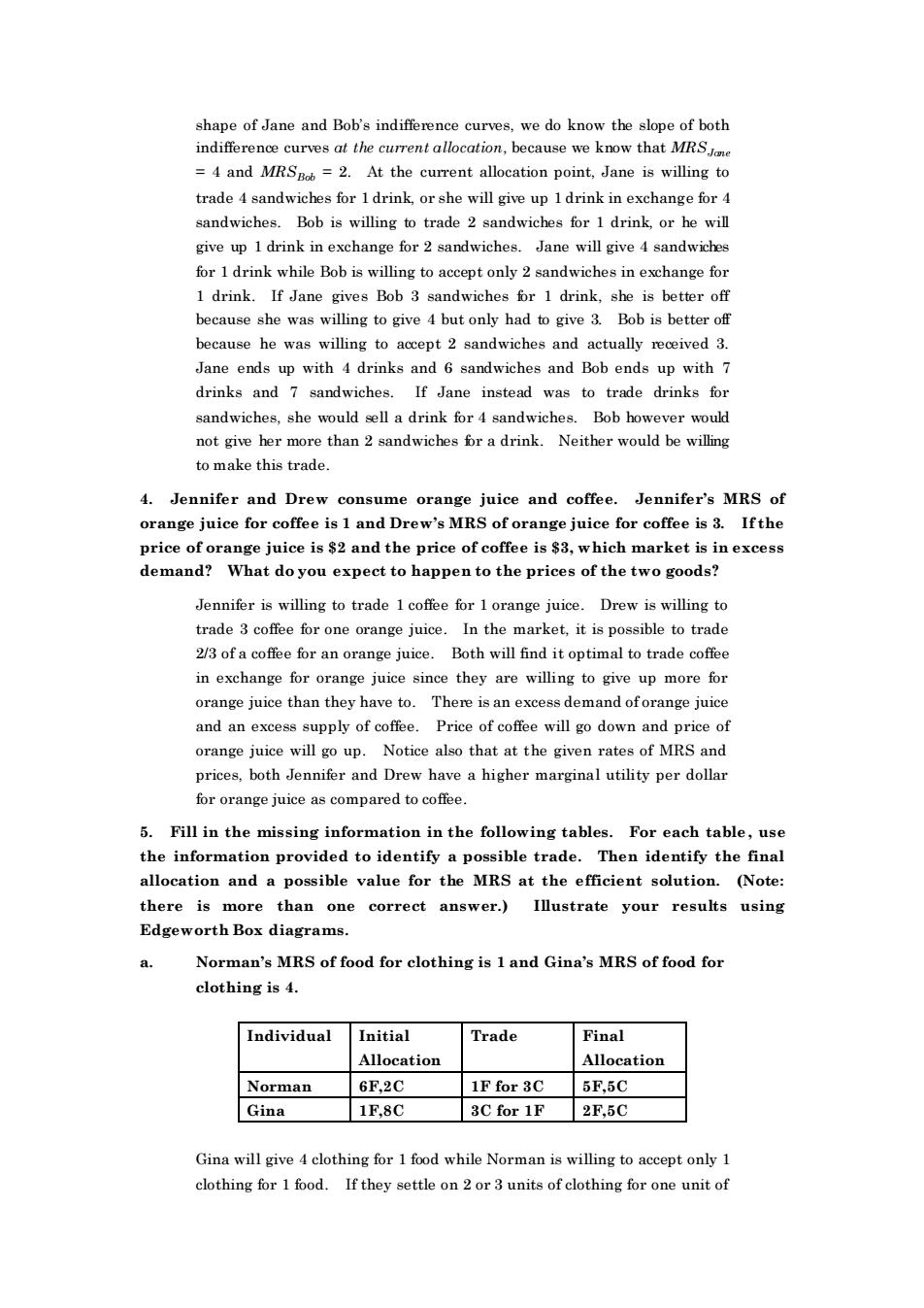正在加载图片...

shape of Jane and Bob's indifference curves,we do know the slope of both indifference curves at the current allocation,because we know that MRS =4 and MRS=2.At the current allocation point.Jane is willing to trade 4 sandwiches for Idrink,or she will give up 1drink in exchange for 4 sandwiches.Bob is willing to trade 2 sandwiches for 1 drink.or he will give up 1 drink in exchange for 2 sandwiches.Jane will give 4 sandwiches for 1 drink while Bob is willing to accept only 2 sandwiches in exchange for 1 drink. 1 drink, she is bette because she was willing to give 4 buton had togive3.Bob is betterof because he was willing to accept 2 sandwiches and actually received 3 Jane ends up with 4 drinks and 6 sandwiches and Bob ends up with 7 drinks and 7 sandwiches.If Jane instead was to trade drinks for sandwiches,she would sel a sandwiches Bob bow not give her more than 2 sandwiches or a drink ver would Neither would be willing to make this trade 4.Jennifer and Drew consume orange juice and coffee.Jennifer's MRS of orange juice for coffee is 1 and Drew's MRS of orange juice for coffee is 3.Ifthe price of orange iuice is s2 and the price of coffee is $3.which market is in excess demand?What do you expect to happen to the prices of the two goods? Jennifer is willing to trade 1cofee for 1orange juice.Drew is willing to trade 3coffee for one orange juice.In the market,it is possible to trad 2/3 of a coffee for an orange juice.Both will find it optimal to trade coffee in exchange for orange juice since they are willing to give up more for orange juice than they have to.There is an excess demand oforange juice and an excess supply of coffee.Price of coffee will go down and p rice of orange jui will go up. Notice also that at the e given rat of MRS prices,both Jennifer and Drew have a higher marginal utility per dollar for orange juice as compared to coffee. 5.Fill in the missing information in the following tables.For each table,use the information provided to identify a possible trade.Then identify the final allocation and a possible value for the MRS at the efficient solution.(Note: there is more than one correct answer.) Illustrate your results using Edgeworth Box diagrams Norman's MRS of food for clothing is 1 and Gina's MRS of food for clothing is 4. Individual Initial Trade Final Allo Allocatior Norman 6F,2C 1F for 3C 5F,5C Gina 1F.8C 3C for 1F 2F,5C Gina will give 4 clothing for 1 food while No man is willing to accept only 1 clothing for 1 food. If they settle on2or3 units of clothing for one unit of shape of Jane and Bob’s indifference curves, we do know the slope of both indifference curves at the current allocation, because we know that MRSJane = 4 and MRSBob = 2. At the current allocation point, Jane is willing to trade 4 sandwiches for 1 drink, or she will give up 1 drink in exchange for 4 sandwiches. Bob is willing to trade 2 sandwiches for 1 drink, or he will give up 1 drink in exchange for 2 sandwiches. Jane will give 4 sandwiches for 1 drink while Bob is willing to accept only 2 sandwiches in exchange for 1 drink. If Jane gives Bob 3 sandwiches for 1 drink, she is better off because she was willing to give 4 but only had to give 3. Bob is better off because he was willing to accept 2 sandwiches and actually received 3. Jane ends up with 4 drinks and 6 sandwiches and Bob ends up with 7 drinks and 7 sandwiches. If Jane instead was to trade drinks for sandwiches, she would sell a drink for 4 sandwiches. Bob however would not give her more than 2 sandwiches for a drink. Neither would be willing to make this trade. 4. Jennifer and Drew consume orange juice and coffee. Jennifer’s MRS of orange juice for coffee is 1 and Drew’s MRS of orange juice for coffee is 3. If the price of orange juice is $2 and the price of coffee is $3, which market is in excess demand? What do you expect to happen to the prices of the two goods? Jennifer is willing to trade 1 coffee for 1 orange juice. Drew is willing to trade 3 coffee for one orange juice. In the market, it is possible to trade 2/3 of a coffee for an orange juice. Both will find it optimal to trade coffee in exchange for orange juice since they are willing to give up more for orange juice than they have to. There is an excess demand of orange juice and an excess supply of coffee. Price of coffee will go down and price of orange juice will go up. Notice also that at the given rates of MRS and prices, both Jennifer and Drew have a higher marginal utility per dollar for orange juice as compared to coffee. 5. Fill in the missing information in the following tables. For each table , use the information provided to identify a possible trade. Then identify the final allocation and a possible value for the MRS at the efficient solution. (Note: there is more than one correct answer.) Illustrate your results using Edgeworth Box diagrams. a. Norman’s MRS of food for clothing is 1 and Gina’s MRS of food for clothing is 4. Individual Initial Allocation Trade Final Allocation Norman 6F,2C 1F for 3C 5F,5C Gina 1F,8C 3C for 1F 2F,5C Gina will give 4 clothing for 1 food while Norman is willing to accept only 1 clothing for 1 food. If they settle on 2 or 3 units of clothing for one unit of